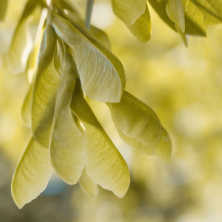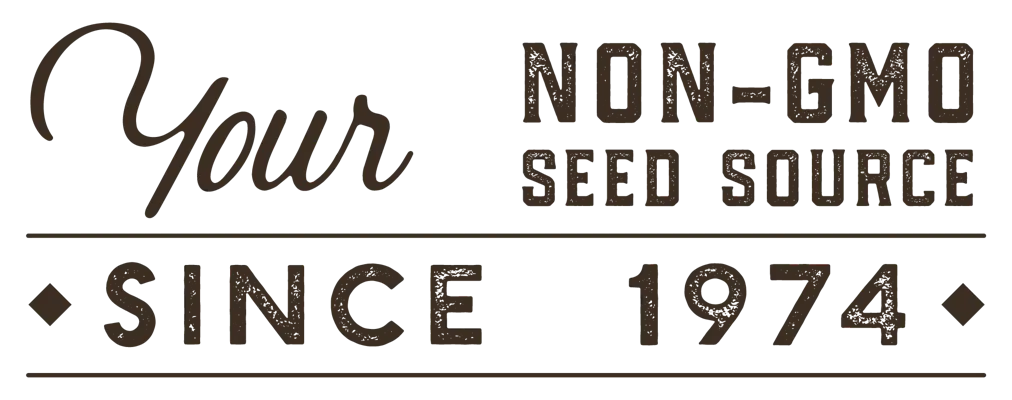How to Harvest Seed
It is essential to recognize that seed harvesting and saving procedures may vary among different types of plants. However, this guide will provide you with the basics to get started. To collect a plant's seed, you should be familiar with where it is located. Below I have listed some examples of how a plant presents its seed. This is not an exhaustive list, but it will help you recognize how seed structures vary. Unlike most of the examples below, garden fruits hold their seeds within the fruit. The key to harvesting fruit seeds is to allow them enough time to ripen, usually longer than you would for eating.

Berries

Capsules

Catkins

Cones

Seedheads

Nuts

Pods

Winged Seed
How To Harvest Vegetable Seeds
As I mentioned earlier, fruits develop their seeds within the fruiting structure such as tomatoes, cucumbers, and beans. Vegetables on the other hand develop seeds on the flowers. Lace-like flowers are especially known to develop hundreds of tiny seeds. Check out the saving small seeds section below for a handy trick to stop losing these seeds in the collection process.
When growing plants with the intention of collecting the seeds, choose self-pollinating annual or perennial varieties. These are the best as they will be the most reliable in producing a true-to-type seed, and they require less attention. Generally, the seed-saving process is to remove the seeds from the fruit, rinse if stored in a wet fruit, then allow them to dry. Store them in a clean, dark, cool place.
Some fruits will have seeds that are coated in a gel mucilaginous layer. This is meant to protect the seed, however, it can prevent germination. To remove it gently rub the seed against a small colander or screen while rinsing with water. After the gel coating has been rubbed off, allow the seeds to dry completely before saving. Below we have outlined some of the most popular methods for saving common seeds and why you might want to start saving your own seeds. For a more complete guide to saving seeds of all types check out "Seed Sowing and Saving" by Carole B. Turner or "Saving Seeds" by Marc Rogers.

Saving Tomato Seeds
- Step 1: Allow the tomato fruit to fully ripen before removing from the plant.
- Step 2: Scoop the seeds out and rinse with water
- Step 3: Saving tomato seeds takes a little bit of additional care as they are contained within a mucilaginous sack. This means there is a protective gel coating the seed. If the gel sac is left on the seed you will have lower germination rates. To remove it, rub the seeds against a mesh screen or colander while rinsing with water.
- Step 4: Once the gel sac has been removed pat the seeds dry and lay flat on a dry paper towel until completely dry.

Saving Pepper Seeds
- Step 1: Allow your peppers to mature on the plant until they become wrinkled.
- Step 2: Remove the pepper seeds and discard any damaged or discolored ones.
- Step 3: Allow to dry completely on a paper towel in a warm area out of direct sunlight. Turn the seeds over every couple of days to ensure they get completely dried before storing.
- Step 4: Best storage practices include maintaining a constant temperature and dry environment. Keep in a cool, dark, dry area in an airtight container. Many people find it very convenient to do this by placing the seeds in a labeled plastic bag, then placing all of your seed bags in a plastic or glass airtight storage container in the refrigerator.

Saving Pea and Bean Seeds
- Step 1: Allow the pods to ripen until dry on the plant. You should be able to hear the seed rattling within the pods.
- Step 2: Collect the pods and dry inside for at least 2-6 weeks.
- Step 3: Either store the seeds in the pods until you are ready to plant, or shell the seed and store until you are ready to use them. Keep the seeds in an airtight bag within an airtight container in the refrigerator.

Saving Lettuce, Carrot, and Other Small Seeds
- Step 1: Allow the plant to flower and die for seed development.
- Step 2: Either pull the seeds off of the flower structure by hand or Cut off the stem and shake the seeds loose into a plastic bucket.
- *If you shake them into a bucket you will want to use a screen to separate the seed from excess plant material.
Seed Storage
Seed storage is really a simple concept. The key to saving seeds is to keep them in a cool, dry, and dark place. Regardless of what type of seed you are storing, you will want to make sure they are completely dry. Usually, this means allowing your seeds to dry for a few weeks up to a couple of months. Any moisture left will eventually lead to molding and unviable seed. To prevent mold problems, some people like to store their seeds with silica gel desiccant or oxygen absorber packets.
Common Seeds To Collect

Support Bees and Other Pollinators - Wildflowers, Milkweed, Clover, Lupine, Coneflower, Cosmos, Poppies, Bergamot, Primrose, and more.

Heirloom fruits, vegetables, and herbs are ideal seeds for saving from season to season because they are open-pollinated. This means they will produce true-to-type fruiting characteristics.

Dry Climates - Wildflowers are always a good option for arid climates as they are often native growers as well. You will also want to prioritize drought-tolerant varieties for the best success.

Mountainous Regions - Wildflowers are the star in dry and high elevation areas. They can handle harsher weather conditions and come back year after year. Prioritize hardy and drought-tolerant varieties. For open areas consider using a mix to fill in thin plant areas for a beautiful cover crop.
Is Seed Saving Legal?
While seed saving and exchanges are widely accepted, there are a few seeds that remain off-limits for saving and trading. Some varieties are patented because of the investments made to commercialize them. These patents protect the breeder by giving them control of the plant's production and sale for 20 years. Following this time, most seeds can be saved on an individual basis. For any seed that is intended for sale, testing and other legal certifications must be met first. If you are planning to participate in any seed exchanges, first make sure you are following appropriate state and local restrictions.
Why Save Seeds?
Seed saving is a long-time tradition for gardeners. Without seed saving, we would not have the plants we have today. The exchanging of seeds has also become a way to connect with the past and preserve new discoveries for future generations. Just as we are constantly tracking new varieties, we are losing many that carried our ancestors through history. While there are many reasons to save your seed, some of the best are: to preserve genetic diversity, maintain a stock of your favorite seed, connect with your garden, feed the bees, and build community.
Genetic diversity is preserved through seed collection as you get to experience genetic combinations not made available commercially.
To accomplish this stability needed to sell seeds, or grow specific produce, they are often inbred to deplete variation probability that can occur through open-pollination. The resulting varieties are sold as hybrid seeds. The problem with saving hybrid seed occurs when the saved seed is grown (pollinated by a random variety) and produces different traits from the original cross.
Heirloom seeds may be sold as these have developed over decades of natural selection. Time allows these genetics to develop a strong claim to dominant features. While there is a possibility for a recessive, or less probable trait to show, it isn’t very likely. Heirlooms are generally seeds with dominant genetics traced back about 50 years or more.

Being able to guarantee specific traits in the fruit of seeds is important as it would be hard to buy seeds for a plant you can’t describe accurately. For example, it would be like buying a tomato that may be yellow but has the potential to revert back to the ancestral influence of red-colored genetics when grown. You just wouldn’t know what you were getting. This is a problem as people like predictability.

Maintaining a stock of your favorite seeds can be quite easy. If you have a habit of only growing heirloom seeds, you can collect them from year to year. This can save you a few dollars, but it will also provide you with seeds in case of an emergency.
Sometimes seed crops experience widespread failure due to pest or disease problems. We have seen the effects of this in the availability of cauliflower seeds throughout 2022. We are also expecting a shortage of paste tomato seeds in the industry for the upcoming 2023 season as this year's crops have struggled.
Besides saving your favorite varieties for emergencies, you can also bond with family members over saved seeds from generation to generation.
Growing and collecting seeds is a great way to connect with, and learn about your family heritage. Have you ever had a great memory of time spent together in the garden? If you have, then you know how special that time is. Preserve today’s memories for the future.
Connecting With Your Garden is really more about connecting with yourself. Nature influences our social, psychological, and emotional health in ways that are continuing to be understood. If you are a person who feels overwhelmed, anxious, stressed, or stuck, you may enjoy spending more time in your garden as a way of calming and grounding your emotions.
Spending time in nature doesn’t have to take a lot of work, and that includes the practice of seed saving. There are only 3 simple steps to make seed saving a hobby. The first step is to get your seeds. Second, plant and watch them grow. Third, when the flowers are spent and seeds have formed, collect the seeds and store them for next year.
Feed The Bees by providing a healthy habitat for them to feed and pollinate. Over the years it has been a well-known issue that honey bees are becoming extinct.
This is a major issue as bees are responsible for ¾ of the world's flowering plant survival and 35% of the world’s food production. You have bees to thank if you enjoy eating apples, beans, cabbage, cucumbers, grapes, kale, lettuce, onions, pears, squash, watermelon, and more.
Seed collecting and planting are important in combatting this issue because we aren’t sure why many plant problems are occurring. There is a large belief that the use of insecticides on commercial crops is contributing due to unintentional drift.

Pesticides do face strict testing in regards to how they will affect bee populations. However, it is impossible to account for all instances where their use may affect bee populations. Use Integrated Pest Management (IPM) practices to create a healthy habitat for your local bees to thrive.

Building Community is a natural part of gardening. Its a hobby that gets you outside and possibly in the view of your neighbors. It also creates a natural topic for discussion among those who share a common interest.
Each year there are hundreds of seed exchange events held around the world. By connecting with others you can expand the variety within your garden, and share a little piece of your own.
Gardening can be a solo hobby, but it doesn’t have to be. If you want to participate in an exchange program, check out the Community Seed Network where you can become a member.



















8 comments
This is my favorite and most rewarding part of gardening is saving the seeds! That also means I get to share with others! Thank you for sharing all of this information!
Thank you so much for this easier tip about tomatoes! I have been mildly fermenting the seeds to get the sack off the seed. But this is way easier!!!
Hi Ashleigh, I am a 70 year-old gardener in Colorado on the eastern plains, and I love your articles! You write beautifully and impart a LOT of great information. I have one suggestion for people saving seeds: I always ferment my tomato seeds to clear the gelatinous membrane and it’s worked for the 64 years I’ve been gardening; then I wash them and to dry them I use a strainer and then I put them on flattened coffee filters. Paper towel will stick to wet seeds, and may interfere with germination if it’s stuck. Just a suggestion. Grow on girl, you’re doing great!
Wow, I had no idea that inside cones has seeds. Loved the blog post about seed savings and what they look like when it’s time for seed saving. I am a newbie gardener and I’m finding these blogs to be super helpful!
I had tried saving seeds unsuccessfully before. Now I’ll know how to make sure they’re really dry and consider saving them out with silica gel. How long will my seeds keep?